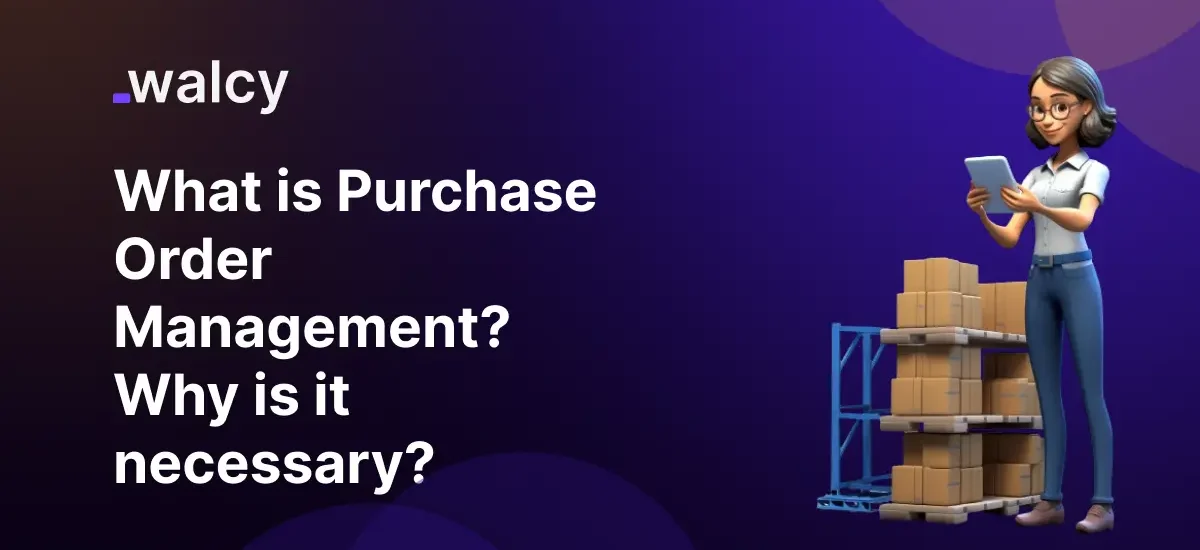Making efficient purchase orders can be the deciding factor in the smooth running of a business and its profitability. Purchase order management becomes an integral part of procurement since it entails the procedures and guidelines put in place to ensure that goods and services ordered are received and accounted for.
A systematic purchase order management system will help save time, reduce errors, and foster closer vendor relationships. In this blog we will analyze everything about purchase order management, outlining exactly why an effective purchase order control system is essential to your business. Additionally, we will discuss the ways to implement an easy purchase order system in your business.
What is Purchase Order Management?
Purchasing order management is the procedure that an organization employs to track and oversee its purchase requests. It handles the entire cycle of purchase requisitioning, approval, tracking, and receiving goods against the purchase order placed with vendors. A purchase order is a document that details the items ordered, the quantity, price, and date of delivery. It ultimately concludes when the goods or services are received, checked for accuracy, and the vendor is paid.
The need to ensure that every purchase is well documented and followed up can be made possible through an effective purchase order entry system. It helps companies not to spend beyond their budget, maintain an average stock level, and uphold a good relationship with the suppliers.
Why a Purchase Order System is Necessary?
A purchase order control system is very essential due to various reasons:
Budget Management:
A purchase order system empowers the business to track expenditures while making purchases of items within the budget constraint. This tends to avoid unauthorized expenditure and thus prevents mismanagement of finances.
Inventory management:
By using an integrated inventory and Purchase Order software, one will know the number of stock levels and order precisely the level of inventory required to avoid overstocking and stock outs.
Reduction of Error:
An organized PO system minimizes the occurrence of errors, such as duplicate orders or incorrect deliveries, by maintaining accurate records of all activities.
Management of Relationship with Suppliers:
With a clean, coherent process for purchase orders, businesses can improve communication and reliability with suppliers for better terms and discounts.
Audit Trail:
Purchase orders provide a paper trail that may become vital in financial audits and compliance. They act like proof of a transaction and mention what was ordered, at what price, and when.
Key Components of Purchase Order Management
To manage purchase orders, the first and foremost important thing is to understand the key components of a purchase order management system:
Create a Purchase Order: This is the initiation step, whereby one identifies the need to acquire goods or services and creates a purchase order. The details contained in this document are very vital and include a description of the goods, quantity, price, and even instructions on how delivery is to be done.
Approval Workflow: This document usually undergoes several approval steps once the PO has been created. This may include various levels of approval depending on how the organization is structured to ensure that there is a need for the purchase and that it is within budget.
Supplier Management: The PO is routed to the supplier after approval. Proper supplier management ensures that the details of the order have been clearly understood by the supplier and that he accepts the specified terms and conditions.
Order tracking: After sending the PO, it is essential to track the progress of an order. An easy purchase order system should be able to let one follow up on the status of his order for its effective delivery and see any hiccups that may be encountered.
Goods receipt and Inspection: On delivery, the goods or services delivered should be checked against the PO to ensure specifications are in order. Any discrepancies should be recorded and communicated back to the supplier.
Invoice Matching and Payment: This is the final step in which the supplier’s invoice is matched against the PO and the goods received. If everything seems fine, the amount can be paid.
Implementing an Easy Purchase Order System
An easy purchase order system will definitely facilitate the smoothness in the flow of the procurement process and reduce errors. The following steps show how to implement this in your business:
Selection of the Right Software: The most important part of the inventory and purchase order software is the selection of the right software piece. Look for an auto-PO generation based on pre-defined parameters, multi-level approval workflows, live tracking, and easy integration with your financial systems.
Customize Your Workflow: Personalize the purchase order process to meet your business requirements. This might include setting different levels of approval for orders or categories or auto-passing some tasks.
Train Your Team: Any member of the team who is going to take part in procurement will need to learn how to work with the new system. Conduct training sessions to introduce the system and develop user guides for transition purposes.
Integrate with Other Systems: To get the most out of your purchase order system’s operation, combine it or integrate it with other systems, like as accounting, inventory management, and enterprise resource planning, or ERP. This will guarantee that data flows freely across your company’s activities.
Monitor and Improve: Periodically review your purchase order process to identify any potential room for improvement. Base your decisions on the data generated by this system, and optimize your procurement strategy.
While purchasing goods from foreign country you can use Walcy to save cost on international payouts.
Benefits of Implementing Inventory and Purchase Order Software
There are several advantages associated with the implementation of inventory and purchase order software. These include:
Automation: Automating the PO process reduces manual work, expedites approvals, and reduces the risk of human error.
Real-Time Data: The availability of data in real-time empowers better decision-making on inventory levels, suppliers’ performance, and budgeting.
Cost Savings: Optimizing the purchase process empowers a company to receive better deals from suppliers and prevent inappropriate spending instances, thereby saving on costs.
Compliance: The automation of systems in purchasing will guarantee that every purchase is performed according to what has been stipulated by the policies of the company, thus reducing the risk of non-compliance with the same.
Scalability: If your business grows, automated management allows easy scaling to higher purchase volumes with much less additional work required.
Conquering Common Challenges of Purchase Order Management
Even using the best PO management system does not leave a company completely immune from potential pitfalls. Here are some of the more common issues and how to navigate them:
Supplier Delays: The delays by the suppliers themselves might hamper your operations. That risk can be reduced if communication happens in the right manner and at the right time, besides developing backup suppliers.
Mismatch between PO and Invoice: Inconsistencies within the PO and supplier’s invoice cause a delay in payment. Set up a three-way match process—PO, goods receipt, and invoice—catching discrepancies early.
Over-ordering: Ordering more than you need ties up capital and increases storage costs. To minimize it you can record and notify purchase orders. Additionally, you can set an order point on your inventory and order software to alert against an overorder.
Lack of Visibility: Without tracking, one loses visibility on the procurement process. A system that has real-time updates with reporting features will improve overall visibility.
The Future of Purchase Order Management
In a few years, with technology continuously in development, so is the realm of purchase order management. Here are some trends that one needs to look out for:
Artificial Intelligence (AI) and Machine Learning: AI can forecast demand patterns, optimize inventory levels, and recommend the best suppliers for making purchase order management more efficient.
Blockchain Technology: Blockchain technology provides a record of all transactions which cannot be altered. This will increase transparency and security in supply chain-related activities.
Cloud-Based Solutions: Cloud-based purchase order entry systems give flexibility and scalability to handle procurement procedures from any location with internet connectivity.
Integration with IoT: The Internet of Things will automate the reordering process by linking inventory levels directly to the purchase order system.
Conclusion
Effective purchase order management ensures the smooth running of any given business. With an easy purchase order system and using the right inventory and purchase order software, companies will make the process of procurement less complicated, slash costs, and have the capacity to relate well with their suppliers. Keeping up with the changing trends and tools, armed with changing times in technology, will ensure that your purchase order management system stays efficient and competitive.
On your way to becoming a pro in purchase order management, with this, you are assured of running your business with precision and control.
Do follow us on Facebook and LinkedIn, to stay connected with us.



